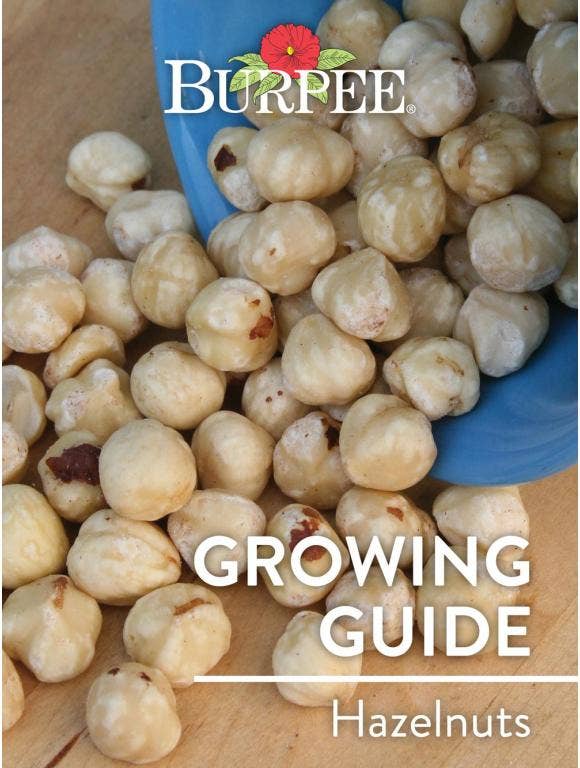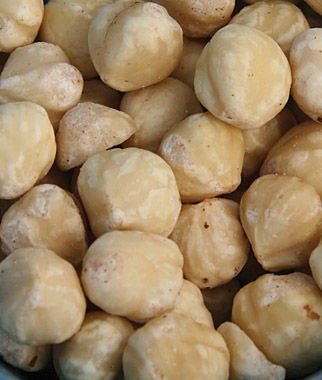
How to Plant
Planting Potted Plants:
- Choose a location in full sun in an area with well-drained soil with a pH of 6.0 to 6.5.
- Hazelnuts are not self-fertile and two trees are needed for cross pollination. Make sure you have enough room for two mature trees spaced 20 feet apart.
- Prepare the bed by turning the soil under to a depth of 6-12 inches removing any debris, and lightly raking as level as possible.
- The addition of organic matter (leaf mold, compost, well-rotted manure) benefits all gardens and is essential in recently constructed neighborhoods.
- Space plants 20 feet apart in the garden.
- Dig a hole at least 2 times the size of the root ball.
- Set the plant in the hole so that the root ball is level with the surrounding soil, backfill and press the soil firmly into the hole cavity.
- Water deeply. The water will seal off any air pockets around the root ball.

How to Grow
- Keep weeds under control during the growing season. Weeds compete with plants for water, space and nutrients. Control them by either cultivating often or use a mulch to prevent their seeds from germinating.
- Mulch around the plants to a depth of 2-3 inches or organic matter to preserve moisture and prevent weeds. For fruit plants an organic mulch of aged bark or shredded leaves lends a natural look to the bed and will improve the soil as it breaks down in time. Always keep mulches off a plant’s stems to prevent possible rot.
- Keep plants well-watered during the growing season, especially during dry spells. Plants need about 1-2 inches of rain per week during the growing season. It's best to water with a drip or trickle system that delivers water at low pressure at the soil level. If you water with overhead sprinklers, water early in the day so the foliage has time to dry off before evening, to minimize disease problems. Keep the soil moist but not saturated.
- Do not fertilize unless leaves are showing a nutrient deficiency
- Male flowers are yellowish, in catkins to 3” long, appearing early spring.
- Hazelnuts tend to sucker; trim away extra sprouts as they emerge at the base to maintain a central trunk. For a more bush-type plant cut out all but 5 to 6 strong stems. No other pruning is needed.
- Monitor for Pests and diseases. Check with your local Cooperative Extension Service for pest controls recommended for your area.
Harvest and Preserving Tips
- Hazelnuts are ½ inch across, enclosed in husks, and ripen in September.
- Harvest hazelnuts after their husks have dried, split and dropped from the tree. Fallen nuts can be raked and cleaned off. If picking earlier, gently pop off the husks encasing the nuts. Harvest regularly, before squirrels and birds do.
- Dry the nuts before storing. Spread the nuts out in a warm and well-ventilated spot. This takes several days; the nutmeats turn dark when dry. Check by cracking nuts in the shell.
- Dry nuts can keep up to 2 years frozen, or for a year in a refrigerator.
- Un-roasted nuts store better. Keep them in a jar or plastic container covered tightly enough to keep out moths. Check stored nuts for mold.
Common Disease Problems
- Anthracnose: This is a fungus disease that attacks the nuts as they are ripening. The first visible sign is a circular spot on the skin that is slightly sunken. The spots enlarge and turn black; the nut rots. Extended periods of heat and humidity facilitate anthracnose growth. The fungus overwinters in diseased plant debris. Burpee Recommends: Plant resistant varieties, provide sufficient space between plants for good air circulation, avoid overhead watering which can spread the fungus spores, keep a clean garden, remove and discard all diseased plant material and rotate crops. Use a mulch to prevent spores from splashing from the soil onto plants.
- Blight: This usually only occurs in young trees. Small oozing cankers appear on the branches and buds, usually in warm weather. Cankers may continue to completely encircle infected branches and kill them. Burpee Recommends: Practice good garden hygiene at the end of the season and discard, do not compost, possibly diseased plants. Space plants to allow for adequate air circulation. Avoid overhead watering which may spread fungus spores. Prune all infected branches below cankers. Contact your county extension for recommendations in your area.
- Eastern Filbert blight: Cankers initially appear on the branches near the top of the tree. Cankers later appear on any part of the plant causing leaves to rapidly wilt and branches to dieback. The disease spreads during wet weather. Burpee Recommends: Plant resistant varieties; Burpee’s hazelnuts are resistant to this disease. Prune out branches and twigs ensuring that the cut be made at least a foot below the canker.
- Powdery Mildew: This fungus disease occurs on the top of the leaves in humid weather conditions. The leaves appear to have a whitish or greyish surface and may curl. Burpee Recommends: Avoid powdery mildew by providing good air circulation for the plants by good spacing and pruning. Contact your Cooperative Extension Service for fungicide recommendations.
- Rust: A number of fungus diseases cause rust colored spots on foliage and stalks. Burpee Recommends. Contact your Cooperative Extension Service for recommendations.
Common Pest and Cultural Problems
- Aphids: Greenish, red, black or peach colored sucking insects can spread disease as they feed on the undersides of leaves. They leave a sticky residue on foliage that attracts ants. Burpee Recommends: Introduce or attract natural predators into your garden such as lady beetles and wasps which feed on aphids. You can also wash them off with a strong spray, or use an insecticidal soap.
- Leafhoppers: Leafhoppers cause injury to leaves and stunt growth. They also spread disease. Burpee Recommends: Remove plant debris. Use insecticidal soaps. Consult your Cooperative Extension Service for other insecticide recommendations.
- Japanese Beetles: Burpee Recommends: Hand pick early in the morning into a bucket of soapy water.
- Scale: Small bugs look like brown, black, gray to white bumps on the stems of plants. Scale may not have any apparent legs and may not move. Scales have a sucking mouth part. Scale may produce honeydew so leaves and stems may be sticky. Scale can weaken the plant causing it to grow very slowly and may wilt at the middle of the day. Burpee Recommends: Completely spray the stems with Insecticidal soap. For a severe infestation contact your local County Extension Service for recommendation for your area.
- Spider Mites: These tiny spider-like pests are about the size of a grain of pepper. They may be red, black, brown or yellow. They suck on the plant juices removing chlorophyll and injecting toxins which cause white dots on the foliage. There is often webbing visible on the plant. They cause the foliage to turn yellow and become dry and stippled. They multiply quickly and thrive in dry conditions. Burpee Recommends: Spider mites may be controlled with a forceful spray every other day. Try hot pepper wax or insecticidal soap. Check with your Cooperative Extension Service for miticide recommendations.
FAQ
Do I need two different varieties of hazelnut to get fruit? Yes, hazelnuts require at least two different varieties to get nuts. Burpee sells them as a set.
Will I get fruit the first year? No, the first fruit should be in 3 years, with full fruit in 7-10 years.
Do hazelnut trees have nice fall color? Yes, fall foliage is very showy yellow to coppery reds.
How do I keep birds from eating the fruit? Check the trees every day for fallen nuts and rake them up. Use bird netting on the trees to prevent them from eating immature nuts.
How long will hazelnut trees last? If well maintained hazelnut trees can last 30 years.


